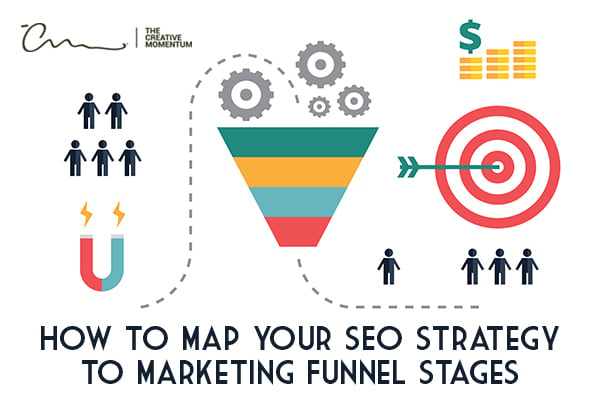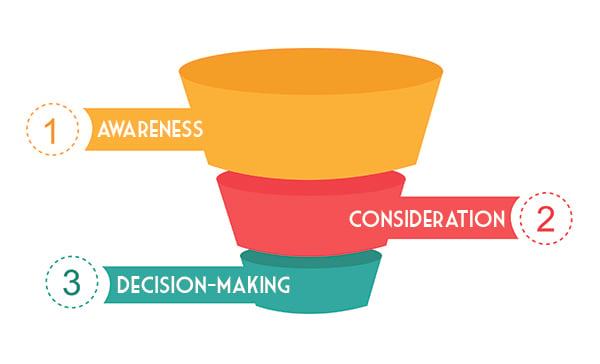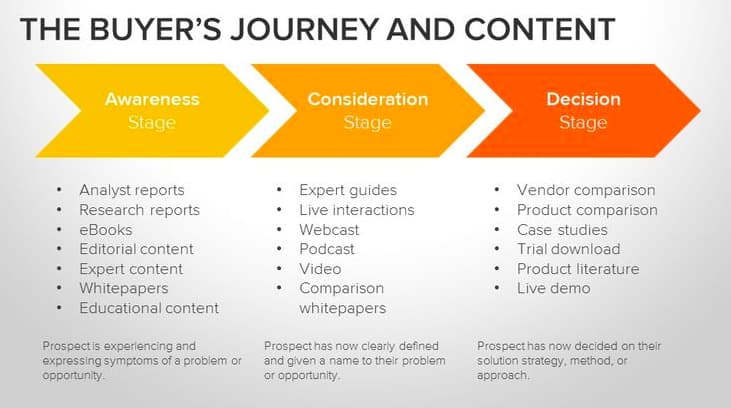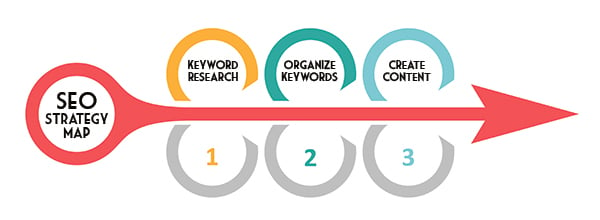
It’s a common belief that search engine optimization (SEO) strategy for marketing is all about gaining online visibility. While that’s basically correct, it’s only part of the picture.
SEO is a vital piece of your marketing strategy. The keyword is “piece.” It’s not meant to exist in a bubble. While SEO can certainly bring traffic to your website, pageviews won’t earn your business money.
If you want to build a successful SEO strategy that actually generates revenue, you need to align it with the stages of the marketing funnel. Here’s what you need to know.
What Are the Marketing Funnel Stages?
This first part of creating an SEO strategy for marketing that maps to the marketing funnel stages is to understand what these stages are.
The marketing funnel is also known as the buyer’s journey. It’s the path potential customers take as they go from problem-solving to converting, or buying.
There are three stages to the buyer’s journey:
 1. Awareness – Top of the Funnel (TOTF)
1. Awareness – Top of the Funnel (TOTF)
The first stage of the marketing funnel, awareness, has the broadest demographic. It’s where you’ll get the most SEO traffic to add to your lead-generation pool.
At this stage, potential customers don’t quite know what service or product they need, if any at all. They know there’s a problem, but they’re not sure what it is or how to solve it.
For example, a buyer in the awareness stage might search something like, “How to boost productivity.” They know they need to become more efficient (the problem), but they haven’t decided much beyond that point.
2. Consideration – Middle of the Funnel (MOTF)
In the middle of the funnel is the consideration stage. This is where buyers know the problem, and they’re looking for solutions.
Using the example from above, a MOTF buyer has already searched “how to boost productivity” and discovered their billing practices are inefficient. Now, they want to find out “what accounts-payable software includes these features I'm looking for?"
3. Decision-Making – Bottom of the Funnel (BOTF)
The last stage of the marketing funnel is decision-making. Potential buyers understand their problem and know how to fix it. The last thing they need is to decide which solution they want to purchase.
Completing the example, your BOTF buyer has already searched for ways to boost productivity and understands knows which features they want in an accounts-payable software. Now, she wants to know, “What is the best accounts-payable software?” This stage will compare the options, so she can finally pull the trigger on a sale.
Why It’s Important to Consider the Marketing Funnel in SEO Strategy
The average SEO conversion rate is 2.4%. This means that if you get a thousand page views, only 24 readers will actually buy your product, sign up for your emails, or fill out a form—which isn’t very good. What’s the benefit of attracting people to your site if you can’t get them to convert?
If you want conversions (which you do), you need to cater your content to the reader. Give users the information they want, and they’ll be more likely to purchase your products or services.
Pretend you want to sell keyboards to help people type faster. These might be some of the common SEO keyword phrases you’d want to rank for:
- How to increase typing speed?
- Top reasons to get a new keyboard
- What’s the best keyboard for typing?
Many companies get into trouble when they fail to think about users’ intentions. They create content for the “How to increase typing speed” keyword phrase, and all they talk about is how great their keyboard is and why people should buy it. Then, they sit back and wonder why nobody is buying their awesome keyboard.
The problem is that users searching for that phrase aren’t ready to buy anything; they’re still in the awareness stage and just want to learn about their problem, and you're selling them a keyword. There's a complete content mismatch between the search phrase you've targeted ("How to increase typing speed") and the article you've created that focuses on all the benefits of your keyboard. Articles that don't seek to genuinely answer the question will not only not rank, but will make your company seem less trustworthy to prospects, and in turn, to search engines.
By mapping your SEO strategy to the marketing funnel, you can create content that drives business and boosts your search engine rankings in order to earn more conversions.
SEO Strategy Mapping 101
As if creating an entire SEO strategy isn’t difficult enough, now you have to align it with the marketing funnel. Luckily, it’s not as hard as it sounds. Just follow these three steps, and you’ll have a conversion-generating SEO strategy to help your business grow.
1. Perform Keyword Research
The first step in creating an SEO strategy is always performing keyword research. Think about what your ideal customers searches for online. You can either put yourself in their shoes and think of terms, enter different keywords in a search engine for more ideas, or use one of the dozens of online tools to analyze search results.
2. Organize Keywords Based on Marketing Funnel Stages
Next, you should organize your keywords based on the marketing funnel stages:
Awareness
The awareness stage is all about helping potential customers understand their problems. These are some of the common keywords for the first stage of the marketing funnel:
-
- Prevent
- Improve
- Troubleshoot
- How to
- Resolve
These keywords are the most important because they appeal to the widest demographic. They’re going to get the most visibility online.
Consideration
Now that potential customers understand their problem, it’s time to start thinking about solutions. Here are keywords to align your SEO strategy with the consideration stage:
-
- Service
- Tool
- Provider
- Device
- Solution
You want to show buyers that a solution exists and convince them that if they get it, their lives will be so much easier!
Decision-making
The final stage of the marketing funnel is about closing the deal. Here are some of the best keywords for the decision-making stage of the buyer’s journey:
-
- Compare
- Pros and cons
- Review
- Versus
- Test
- Trial
These keywords might appeal to the smallest demographic, but they’ll generate the highest percentage of conversions.
3. Create Your Content
With your keywords mapped to the marketing funnel stages, the only thing left to do is create your content. But remember, your keywords aren’t the only things that need to be aligned to the buyer’s journey; your content does too.
Here are some of the best content types for each stage of the marketing funnel:
- Awareness stage
- educational blog posts
- analyst reports
- industry research
- Consideration stage
- case studies
- expert guides
- whitepapers
- Decision-making stage
- reviews
- product comparisons
- demos

This handy flyer from HubSpot outlines what content is commonly associated with different marketing funnel stages. Source: HubSpot
Don’t forget to lead viewers to the next stage of the marketing funnel. Your awareness stage content should link to your consideration stage content, and your consideration stage content should link to your decision-making stage content. Always try to guide visitors farther down the sales funnel.
When your keywords and content align with the marketing funnel, your SEO strategy will be unstoppable.
Create an Effective SEO Strategy
Building an SEO strategy for marketing your business is more than just picking out a few keywords and building content to boost online rankings. It takes an in-depth knowledge of your customers’ journeys. When you align your SEO strategy to the marketing funnel stages, you’ll get more than pageviews; you’ll generate conversions.
Do you need more help? If you’re ready to create an SEO strategy with the marketing funnel in mind, get in touch. We offer comprehensive SEO services to help your company get the online visibility (and sales) it deserves. Contact us for a free consultation. We look forward to hear about your project!




